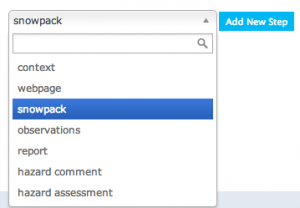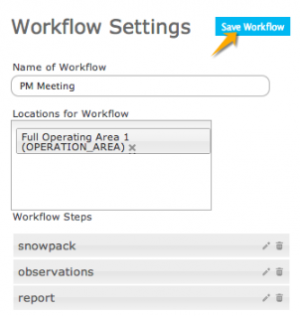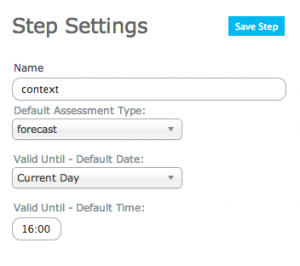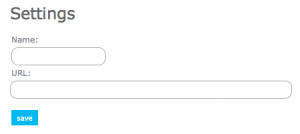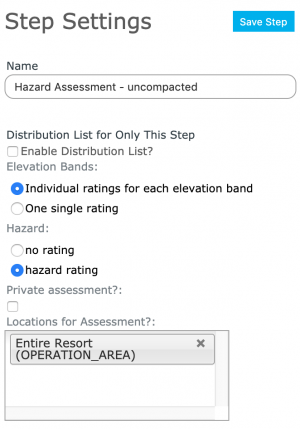Difference between revisions of "Creating a workflow template"
Jump to navigation
Jump to search
(→Adding steps to the workflow template) |
(→Adding steps to the workflow template) |
||
| Line 53: | Line 53: | ||
* Only one [[Snowpack module]] step is allowed per workflow template | * Only one [[Snowpack module]] step is allowed per workflow template | ||
* Only one [[Hazard assessment module]] or [[Hazard comment module]] step is allowed per workflow template. These two modules were intended as high- and low-tech alternatives for supporting avalanche hazard assessment.|NoteWithImage}} | * Only one [[Hazard assessment module]] or [[Hazard comment module]] step is allowed per workflow template. These two modules were intended as high- and low-tech alternatives for supporting avalanche hazard assessment.|NoteWithImage}} | ||
| + | {{Note|The [[Context module]] cannot explicitly be added to a workflow. Instead, it is automatically added at the beginning of any workflow that includes a data submitting module.}} | ||
|- | |- | ||
|class="StepNum" | 2. | |class="StepNum" | 2. | ||
| Line 76: | Line 77: | ||
|class="StepNum" | 5. | |class="StepNum" | 5. | ||
|Repeat steps 1 to 4 until you have created your entire workflow. | |Repeat steps 1 to 4 until you have created your entire workflow. | ||
| − | {{Note|A [[Context module]] is automatically added at the beginning of | + | {{Note|A [[Context module]] is automatically added at the beginning of any workflow that includes a data submitting module.}} |
|- | |- | ||
|class="StepNum" | 6. | |class="StepNum" | 6. | ||
Revision as of 16:26, 24 December 2013
| REQUIREMENTS | |
| Permission | Operation administrator and higher |
| Connectivity | Online and partial offline |
This document describes how to create a new workflow template in the InfoEx system.
Background
A workflow template links together user-specified tasks into a logical order so that users can repeatedly move through the same steps. See Workflow overview for more background information on this feature of the InfoEx application.
Creating a workflow template consists of three main steps:
- Creating a workflow template and choosing its general features
- Adding steps to the workflow template
- Saving the workflow template
Step-by-step description
Creating a workflow template and choosing its general features
| 1. | Click on WORKFLOWS in the main menu and select ‘Manage workflow definitions’. This will take you to the ‘Manage Workflows’ page of the InfoEx application (Fig. 1). | ||||
| 2. | Under the column heading 'Workflows' you will see a list of existing workflows (if any) and an Add New Workflow button. Clicking this button begins creation of a new workflow and open the central panel of the screen with the title 'Workflow Settings' (Fig. 2). This is the area where you specify the general settings of your workflow. | ||||
| 4. | Enter a meaningful name for the workflow into the 'Name of Workflow' field. | ||||
| 5. | If you are planning to include any workflow modules that involve data submission (Observations module, Snowpack module, Hazard assessment module, Hazard comment module), you need to associate your workflow to a location. Enter one or multiple locations into the 'Locations for Workflow' field by clicking on it and start typing. The dropdown list will show your location catalog filtered to what matches your typing.
|
Adding steps to the workflow template
| 1. | To add a step to your workflow template, select one of the available modules from the dropdown list under the 'Workflow Steps' section title (Fig. 3). The currently available workflow modules include:
| ||||
| 2. | Click on Add New Step add a step of the chosen workflow module to your workflow (Fig. 3). This will add
| ||||
| 3. | Specify the module-specific settings for the workflow step. See the documentation on the individual workflow modules for more information on the available settings:
| ||||
| 4. | Click on Save Step to save the module-specific settings for the step that you just added to your workflow. | ||||
| 5. | Repeat steps 1 to 4 until you have created your entire workflow.
| ||||
| 6. | To change the order of steps in your workflow, click on the label of your step under the 'Workflow Steps' section title and drag it up or down to the desired location within your workflow. | ||||
| 7. | You can specify whether the steps in your workflow need to be completed in strict order (i.e., no skipping steps) by checking the checkbox provided as the last item under the 'Workflow Settings' column.
|
Saving the workflow template
| 1. | Click on Save Workflow to save your workflow. |
Details of: Types of workflow steps and the information required to set them up
| Context: | A 'context' step provides information about the workflow itself and offers a place to record the following information:
| ||||
| Webpage: | A 'webpage' step allows the workflow user to view a stored webpage without leaving the application. The following information is required to set it up:
| ||||
| Snowpack: | A 'snowpack' step allows the workflow user to add a snowpack description in narrative form. The following information is required to set it up:
| ||||
| Observation: | An 'observation' step allows you to fill out a customized observation as part of the workflow. The following information is required to set it up:
| ||||
| Reports: | A 'report' step allows you to view a customized infoex report as part of the workflow. The following information is required to set it up.
| ||||
| Hazard Comment: | A 'hazard comment' step allows you to create and add a comment about avalanche hazard in narrative form to your workflow. The following information is required to set it up:
| ||||
| Hazard Assessment: | A 'hazard assessment step allows you to create and add a hazard assessment to your workflow. The following information is required to set it up:
|
Related documents
- xxxx
Functionality tested by
- Date: Nov. 15, 2013 / John Kelly / QA Server / Version 3.0.0


